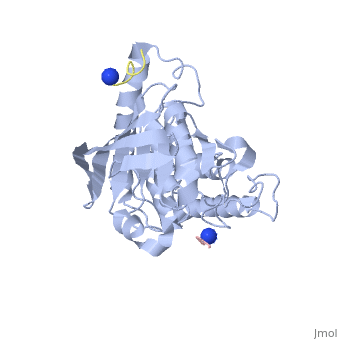1xxv
From Proteopedia
Yersinia YopH (residues 163-468) binds phosphonodifluoromethyl-Phe containing hexapeptide at two sites
Structural highlights
FunctionYOPH_YEREN Essential virulence determinant. This protein is a protein tyrosine phosphatase. The essential function of YopH in Yersinia pathogenesis is host-protein dephosphorylation. It contributes to the ability of the bacteria to resist phagocytosis by peritoneal macrophages. Evolutionary ConservationCheck, as determined by ConSurfDB. You may read the explanation of the method and the full data available from ConSurf. Publication Abstract from PubMedYopH is a protein tyrosine phosphatase and an essential virulence determinant of the pathogenic bacterium Yersinia. Yersinia delivers YopH into infected host cells using a type III secretion mechanism. YopH dephosphorylates several focal adhesion proteins including p130Cas in human epithelial cells, resulting in disruption of focal adhesions and cell detachment from the extracellular matrix. How the C-terminal protein tyrosine phosphatase domain of YopH targets specific substrates such as p130Cas in the complex milieu of the host cell has not been fully elucidated. An N-terminal non-catalytic domain of YopH binds p130Cas in a phosphotyrosine-dependent manner and functions as a novel substrate-targeting site. The structure of the YopH protein tyrosine phosphatase domain bound to a model phosphopeptide substrate was solved and the resulting structure revealed a second substrate-targeting site ('site 2') within the catalytic domain. Site 2 binds to p130Cas in a phosphotyrosine-dependent manner, and co-operates with the N-terminal domain ('site 1') to promote efficient recognition of p130Cas by YopH in epithelial cells. The identification of two substrate-targeting sites in YopH that co-operate to promote epithelial cell detachment and bacterial virulence reinforces the importance of protein-protein interactions for determining protein tyrosine phosphatase specificity in vivo, and highlights the sophisticated nature of microbial pathogenicity factors. Two substrate-targeting sites in the Yersinia protein tyrosine phosphatase co-operate to promote bacterial virulence.,Ivanov MI, Stuckey JA, Schubert HL, Saper MA, Bliska JB Mol Microbiol. 2005 Mar;55(5):1346-56. PMID:15720545[1] From MEDLINE®/PubMed®, a database of the U.S. National Library of Medicine. See AlsoReferences
| ||||||||||||||||||||


